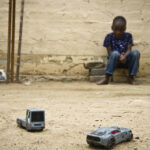A grassroots Ugandan health initiative has significantly reduced maternal deaths.
Six years ago Betty Walakira’s world came crashing down around her. She believed the nonprofit organisation she founded in Uganda in 2005, Health Child, would cease to exist after one of its international donors told her it could no longer fund the project that educated mothers in how to give birth safely. “Have women stopped dying?” the healthcare worker asked herself. “Have our women stopped giving birth? Is Uganda still a priority country?”
That same year, 2011, so many mothers died in Uganda that the World Health Organisation (WHO) issued a report identifying the East African country as one of the 10 countries in the world that contributed the most to maternal and child deaths.
The report put the maternal mortality rate – the number of women who die during pregnancy, childbirth or within 42 days thereafter – at 440 deaths for every 100 000 live births. This is almost double the average rate for developing countries, 216 deaths for every 100 000 live births, according to 2015 WHO estimates.
Developed countries record an average of 12 deaths for every 100 000 live births.
Maternal and child mortality
Uganda also ranked 19th globally for the high number of deaths of children younger than five, according to the report. The risk of dying before reaching their fifth birthday is 45% higher for Ugandan children from rural areas compared with those living in cities.
The high maternal death rate in the country is a result of “health systems challenges and poor social determinants of health” combined with the fact that more than 60% of “women are delivering outside health facilities without skilled care”, according to the report.
Statistics from the Ugandan health ministry show that almost 90% of women from middle-class households give birth in health facilities. But less than half of poor women deliver their babies in a hospital or clinic.
“This is a consequence of not knowing the importance of delivering among skilled health workers in case of problems. But the cost of transport is also a huge barrier for these women – especially because the nearest clinic is often many, many miles away,” says Walakira.
And people are often asked by health workers to pay for services in public facilities despite government policies stipulating that they should be free, according to the nonprofit legal and advocacy organisation, the Centre for Health, Human Rights and Development.
A change in funding
Walakira found a solution to the funding problem – she changed the model. “I realised that the only source of funding possible would be the women and the communities we work with.”
Through Health Child, she founded a new project in 2011 called Sigha Ensihgo Okungile, which means “sow a seed to reap” in the Luganda language. “Uganda loses so many women due to pregnancy – almost 6 000 each year – and most of these deaths are preventable,” she says. “That is, if they have access to information and health services.”
Walakira says she “could not just stand by while this continues to happen”. “I had to think of a way to continue to support these women.”
Sigha Ensihgo Okungile targets poor communities in rural Uganda by forming groups of between 20 and 30 women and a few men, who are “given health education and are encouraged to collectively save money to assist the pregnant women in the group”.
Through this project, Health Child formed groups in the Lira and Apac districts of northern Uganda. The groups consisted mainly of residents from fishing communities, who agree on a fixed weekly amount for individuals to contribute – usually about 2 000 Ugandan shillings (less than $1).
“In these resource-constrained settings very few women can afford everything they need to ensure the health of themselves and their baby – things like transport to facilities, warm baby clothes and hygiene products,” she says.
A helping hand for pregnant women
In its first year, the project worked with 450 pregnant women and managed to almost double the number giving birth in health facilities to 88% – on par with more affluent Ugandan women in urban centres.
“We also saw many more women attending the minimum four ante-natal clinic visits – 80% – as a result of our education about the importance of this,” Walakira says.
These groups meet once a week to pool their money – an agreed on amount that everybody pays.
“At these meetings we give health talks on different topics, from danger signs during pregnancy to the importance of hygiene when it comes to newborns,” says Walakira.
The organisation also makes safe delivery kits consisting of “all the basics needed after birth”, which includes blankets, a shallow bucket, warm baby clothes and soap.
“To make this affordable to the groups we got suppliers to either donate items or lower the cost,” Walakira says.
“And because we tell them about the importance of these things, people are more willing to contribute small amounts of money – which they do not have a lot of.”
Mobile money transfer system
To make saving and money collection easier, Health Child, through the Sigha Ensihgo Okungile project, partnered with cellular service provider MTN in 2014 to create a mobile money transfer system so that money can be sent using SMSs. It is withdrawn at local banks using a special code.
“After we introduced this we saw more men becoming interested – now they form about 20% of most groups,” Walakira says. “Men are important in this context because they are usually the ones who are employed or at least have more income.”
A group leader manages the money, providing pregnant women in the group with between about $10 to $15 that they need for transport to clinics for antenatal appointments and for when they give birth. The leader also purchases the kits needed for when women deliver their babies at health facilities.
In 2014, more than 2 000 people in 71 groups were participating in the project, which had expanded to include the Jinja and Wakiso districts in eastern and central Uganda.
In that year, 1 423 women gave birth with 99% (1 416) delivering their babies in health centres. About 80% attended all four required antenatal appointments and 77% used postnatal services within six weeks after delivery, says Walakira.
A drop in maternal and child mortality
According to Health Child’s research, there were no maternal deaths in the groups and child mortality fell from nine deaths for every 1 000 births in 2013 to four for every 1 000 in 2014.
“Even though these are poor communities, we’ve found that people are willing to invest in health – especially once they have the knowledge of how it will benefit them,” says Walakira. “Our target for this year is to get 10 000 women mobilised into saving groups – and I think it is possible.”
The 2011 WHO report echoes Walakira’s words: “Spending on women’s and children’s health is an investment, not just a cost, contributing to the wellbeing of families and communities … [projects should be] enabling ‘more money for health’ and ‘more health for money’.”
Walakira says that many public health initiatives “fail to empower the people they are trying to help” by “failing to acknowledge the existing resources at all levels that can improve the quality of life for children and their caregivers”.
“Every child deserves the best in life; to be provided for, cared for, loved and protected. And being prepared for giving birth, as a mother, should not only be a luxury for the rich.”
Amy Green was a health reporter at Bhekisisa from 2013 until 2016.





